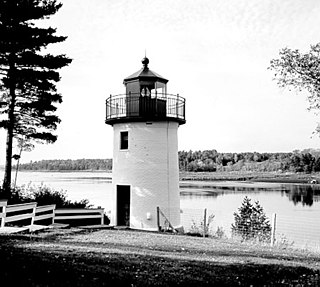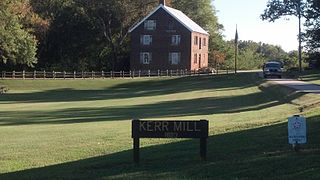
Lansing is a town in Ashe County, North Carolina, United States. The population was 126 at the 2020 census.

The George H. Cox House is a historic house located at 701 E. Grove St. in Bloomington, Illinois. It is considered a particularly fine example of the residential work of architect George H. Miller.

The Whitlocks Mill Light is a lighthouse on the south bank of the St. Croix River in Calais, Maine. It is the northernmost lighthouse in the state of Maine, and was the last light to be built in the state.

This list includes properties and districts listed on the National Register of Historic Places in Rowan County, North Carolina. Click the "Map of all coordinates" link to the right to view an online map of all properties and districts with latitude and longitude coordinates in the table below.

Mascot Roller Mills, also known as Ressler's Mill, is an historic, American grist mill complex that is located in Upper Leacock Township, Lancaster County, Pennsylvania.

Grimes Mill was located at 600 N. Church St. in Salisbury, North Carolina. It was built in 1896 as a flour and feed mill. It stayed active until 1982. The Historic Salisbury Foundation bought it that year and later turned it into a museum. It was listed on the National Register of Historic Places and was the only roller mill museum in North Carolina. The site was destroyed by fire on January 16, 2013.
Darlington Industrial Historic District is a national historic district located at Darlington, Darlington County, South Carolina. The district encompasses 12 contributing buildings and 1 contributing structure in an industrial section of Darlington. They were built between about 1890 and 1925. All of these buildings are located along the rights-of-way of the South Carolina Western Railway and the Charleston, Sumter and Northern Railroad since the industries each of these buildings served employed the services of the railroad. Among the prominent resources in the district are the Charleston, Sumter and Northern Railway Freight Station (1891), the Darlington Roller Mill (1899), Thomas and Howard Tobacco Warehouse ; and Price's Tobacco Warehouse, and a cotton warehouse.
Dunavant Cotton Manufacturing Company, also known as Alpine Cotton Mill No. 1, is a historic cotton mill located at Morganton, Burke County, North Carolina. It is a two-story, brick-clad, side gable-roofed building. The original section was built in 1888–1910, with additions and expansions through 1966. The additions to the building, made in the mid to late 1960s were removed in 2012 to reveal the original 1888-1910 mill building. It is the oldest cotton textile mill in Morganton, and was in use as a cotton textile mill until 1949.
John Bunyan Green Farm is a historic home and farm and national historic district located near Midland, Cabarrus County, North Carolina. The district encompasses 12 contributing buildings, 2 contributing sites, and 1 contributing structure. The farmhouse was built about 1880, and is a two-story, frame dwelling with Italianate style design elements. It features a two-story gabled front porch, a gable roof, and two exterior end chimneys. Also on the property are the contributing ten outbuildings, well canopy, the Garmon Mill site, the miller's house, and the fields and woods.

Grimes Brothers Mill, also known as Lexington Roller Mill and Excelsior Mill, is a historic flour mill located at Lexington, Davidson County, North Carolina. It was built about 1885, and is a four-story brick building with a basement. It measures approximately 34 feet by 40 feet and has a shallow-pitched shed roof. The mill remained in operation until about 1960, and the building was converted to bank use in the early 1960s.

Kinchen Holloway House, also known as Guess Mill House, is a historic home located at Durham, Durham County, North Carolina. It was built about 1870, and is a two-story, three bay, frame I-house with a one-story, gable-roof rear ell. It was built by Kinchen Holloway, a farmer and miller.

Hoots Milling Company Roller Mill, also known as Charles A. Bunn Company Office and Warehouse, is a historic roller mill and warehouse located at Winston-Salem, Forsyth County, North Carolina. The mill was built about 1935, and is a two-story heavy timber and frame building, with an attached two-story heavy timber and frame warehouse built about 1937. A one-story, metal-sided, front-gable-roofed, warehouse was built in the 1930s. A one-story warehouse added in the 1950s connected the two buildings. The mill incorporates a gabled grain elevator.
Clifton House and Mill Site is a historic home and grist mill site located near Royal, Franklin County, North Carolina. It was built in the 1850s, and is a two-story, rectangular frame house with a hipped roof in the Greek Revival style with Italianate design elements. It features a two-story pedimented front porch and has a two-story rear ell. Also on the property are two contributing 19th-century outbuildings, Miller's House, and the ruins of a grist mill built about 1831, including some machinery.

Seaboard Milling Company, also known as Seaboard Roller Mill and Broadway Roller Mills, is a historic roller mill located at Sanford, Lee County, North Carolina. It was built in 1915–1916, and is a three-story, brick building with a gable roof with stepped end parapets and traces of decorative exterior painting. It has a one-story metal-sided frame wing erected in two phases about 1920, and a one-story cinder-block office wing from the early 1950s.
Savona Mill, also known as Savona Manufacturing Company, Alfred Cotton Mill, and Old Dominion Box Company, is a historic textile mill located at Charlotte, Mecklenburg County, North Carolina. The building consists of four sections, three of which are historic. They are the 1915-1916 Weave Mill, a one-story rectangular brick building with segmental arched head windows, a low gable roof with exposed beam ends and a wood clerestory monitor roof; the 1921 Spinning Mill, a three-story rectangular brick building with large rectangular steel windows; and the 1951 three-story Paper Warehouse addition. The Weave Mill was designed by Lockwood, Greene & Co.; Richard C. Biberstein designed the Spinning Mill.

China Grove Roller Mill is a historic roller mill building located at China Grove, Rowan County, North Carolina. It was built in 1903, and is a three-story, rectangular brick building, with several later additions. It retains the intact original milling machinery.

Kerr Mill is a historic grist mill building located near Mill Bridge, Steele Township, Rowan County, North Carolina. It was constructed in 1823 by Joseph Kerr, a large plantation owner. The mill is a brick building with two-stories and three bay by two bay. It rests on a stone foundation and has a gable roof. The mill was operated commercially until the 1940s and has since been refurbished as part of Sloan Park run by Rowan County. The mill and surrounding property are operated by Rowan County as Sloan Park.

Cockerham Mill is a historic grist mill located near Crumpler, Ashe County, North Carolina. It was built between 1884 and 1899, and is a two-story, side-gable, building of post and beam construction. Associated with the mill is the one and a half - story, side-gable single-pile, miller's house, dam, molasses cooking shed, and two-story frame gambrel-roof bank barn.

The Old Red Mill and Mill House are a historic 19th-century mill building and residence on Red Mill Drive in Jericho, Vermont. The mill was built in 1856 and enlarged later in the 19th century, accommodating then state-of-the art grain rollers, and was a prominent local business. The house was built in 1859, and is a good local example of Gothic Revival architecture. The mill is now a museum property of the local Jericho Historical Society. The mill building was listed on the National Register of Historic Places in 1972; the listing was expanded to include the house in 1976.


















